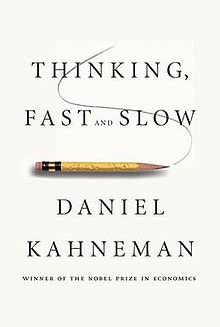Thinking, Fast and Slow

Hardcover edition
|
|
| Author | Daniel Kahneman |
|---|---|
| Country | United States |
| Language | English |
| Subject | Psychology |
| Genre | Non-fiction |
| Publisher | Farrar, Straus and Giroux |
|
Publication date
|
2011 |
| Media type | Print (hardcover, paperback) |
| Pages | 499 pages |
| ISBN | |
| OCLC | 706020998 |
Thinking, Fast and Slow is a best-selling book published in 2011 by Nobel Memorial Prize in Economics laureate Daniel Kahneman. It was the 2012 winner of the National Academies Communication Award for best creative work that helps the public understanding of topics in science, engineering or medicine.
The book summarizes research that Kahneman conducted over decades, often in collaboration with Amos Tversky. It covers all three phases of his career: his early days working on cognitive biases, his work on prospect theory, and his later work on happiness.
The central thesis is a dichotomy between two modes of thought: "System 1" is fast, instinctive and emotional; "System 2" is slower, more deliberative, and more logical. The book delineates cognitive biases associated with each type of thinking, starting with Kahneman's own research on loss aversion. From framing choices to people's tendency to replace a difficult question with one which is easy-to-answer; the book highlights several decades of academic research to suggest that people place too much confidence in human judgement.
Kahneman developed prospect theory, the basis for his Nobel prize, to account for experimental errors he noticed in Daniel Bernoulli's traditional utility theory. According to Kahneman, Utility Theory makes logical assumptions of economic rationality that do not reflect people's actual choices, and does not take into account cognitive biases.
One example is that people are loss-averse: they are more likely to act to avert a loss than to achieve a gain. Another example is that the value people place on a change in probability (e.g., of winning something) depends on the reference point: people appear to place greater value on a change from 0% to 10% (going from impossibility to possibility) than from, say, 45% to 55%, and they place the greatest value of all on a change from 90% to 100% (going from possibility to certainty). This occurs despite the fact that under traditional utility theory all three changes give the same increase in utility. Consistent with loss-aversion, the order of the first and third of those is reversed when the event is presented as losing rather than winning something: there, the greatest value is placed on eliminating the probability of a loss to 0.
...
Wikipedia
